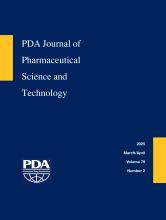Abstract
To address patient safety, a drug product is chromatographically screened for organic leachables. Similarly, medical device and packaging system extracts are chromatographically screened for organic extractables as probable leachables. To protect patient health, the screening methods must respond to all potentially unsafe substances. To be efficient, analytes determined to be below the toxicologically relevant threshold are removed from consideration, before the subsequent analytical tasks of identification and quantitation are performed. The analytical evaluation threshold (AET) was established for use as a toxicologically relevant threshold to differentiate between chromatographic peaks that are unlikely to be unsafe (and thus do not need safety assessment) and those that are possibly unsafe (and thus require safety assessment). In practice, the instrumental response associated with the AET is determined using surrogate standards. It is then assumed that the response strength for an unknown extractable is equivalent to that for the surrogate standard at the AET concentration (i.e., relative response factor = 1). It is an unfortunate reality that response factors vary for different compounds on nearly all detector systems. This complicates the application of the AET and can result in a failure to include potentially toxicologically relevant compounds in the identification phase of the analysis. To ensure protection, an uncertainty factor was built into the AET equation which adjusts downward the AET to address response variation. While this mechanism does increase the protectiveness of the AET, it assumes that the available methodology and instrumentation is sufficiently sensitive to reach the new lowered AET value. However, in some cases the response variation is so great and the resulting uncertainty factor so large that the revised AET is below the achievable sensitivity specifications of even state-of-the art, expertly operated instrumental technologies. The only option then remaining is to concentrate the samples which can result in adverse effects on analysis quality − counteracting the perceived benefit of lowering the AET. This manuscript demonstrates how an analytical strategy based on methods with multiple complementary and orthogonal detection techniques (a multidetector approach) mitigates the problem of response factor variation and thus eliminates the need for large uncertainty factors and the resulting lower AET values. The primary concept is that all analytes only need to be effectively detected by at least one of the combination of detectors applied and it is this effective technique (combination of all detectors and chromatographic methods utilized) that is used to perform the AET assessment.
- Extractables
- analytical evaluation threshold
- analytical evaluation threshold (AET)
- leachables
- multidetector approach
- response factor variation
- Received May 29, 2020.
- Accepted November 5, 2020.
- Copyright © 2020, Parenteral Drug Association






